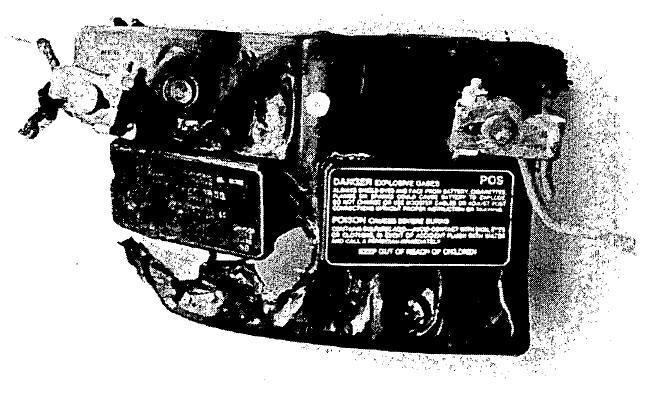Propagation Time
Dodge Caravan Crash Test and Fire
The next crash test and fire involved a 1996 Dodge Caravan Sport struck by a 3,611 lb. deformable moving barrier in a frontal impact at 65 mph; the impact was offset 47% to the driver's side and at a 25 degree angle such that the principal direction of force was through the center of gravity of the Caravan [1]. The engine of the Caravan was operated at high idle for one hour and 46 minutes prior to the crash to simulate on-road exhaust system operating temperatures.
According to the test report:
"There were three separate electrical occurrences caused by the collision, which in combination, caused the post-impact fire.
One event was the pinching and partially severing of a wiring harness between the front edge of the left frame rail and the transaxle housing...Several wires in this harness, including the starter cable, were shorted to chassis. The insulation on the starter cable showed signs of melting and there was evidence of corrosion caused by electrical arcing at the tips of the copper wire. Also, electrical arcing eroded a small area of the frame rail...
A second electrical event noted during the test was the disconnection of the negative terminal from the internal plates of the battery (which was identified during the post-test inspection of the battery). The disconnection was caused by the motion of the battery top and terminals upwards during the impact (which was observed in the high speed film). The entire system will not operate and current will not flow without a battery ground...
A third electrical event that was noted was the penetration of a self-tapping screw into the battery contacting the negative (and possibly positive) plates inside the forward cell of the battery. The screw was identified during the disassembly of the battery and the penetration was noted from inside the battery housing. The screw initially mounted the metal bracket holding the power distribution center housing.
The penetration of the screw into the battery resulted in local resistive heating of both the screw and the surrounding steel structure to which it was mounted...
The shorting of the starter cable, the disconnection of the negative battery terminal, and the penetration of the screw into the battery, in combination, were the causes of the electrical fire. However, in drawing conclusions on how post-impact fires might start, the specific outcome of this test should not be regarded as determinative. It is impossible to determine the repeatability of these specific occurrences, or whether they were affected by the modifications made to the production vehicle in this specific test. As an example, the removal of the hood could have increased the vertical displacement of the battery contributing (to) the separation of the negative battery cable."

Photograph of the burn-damaged battery after the crash and fire.
A video clip of the Caravan crash test and fire can be reviewed by clicking the play button below.
References
Jensen, J., et al., "Evaluation of Motor Vehicle Fire Initiation and Propagation Part 2: Crash Tests on a Passenger Van." NHTSA docket number 98-3588-30, 1998.